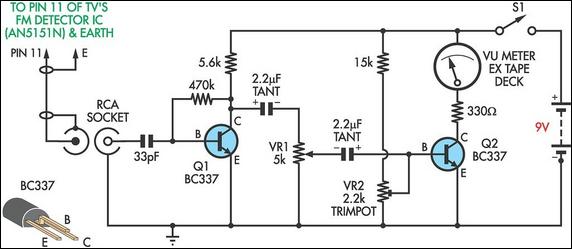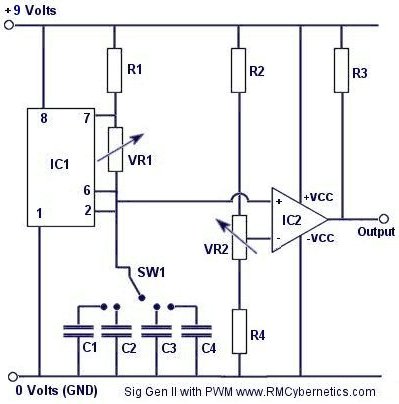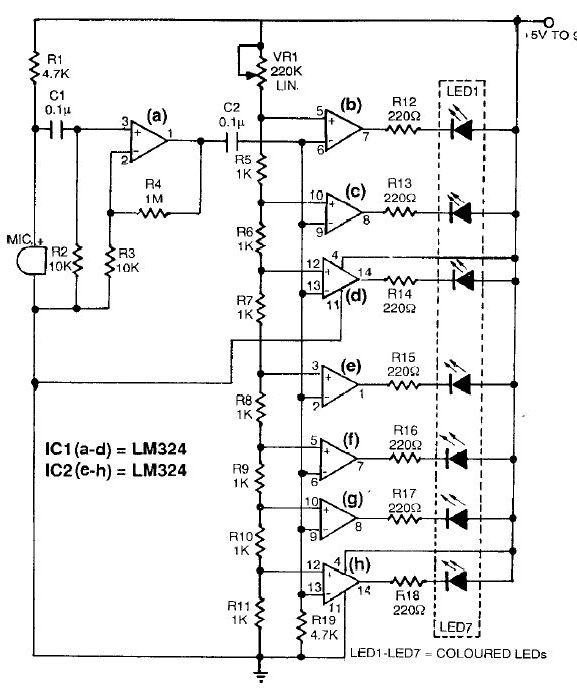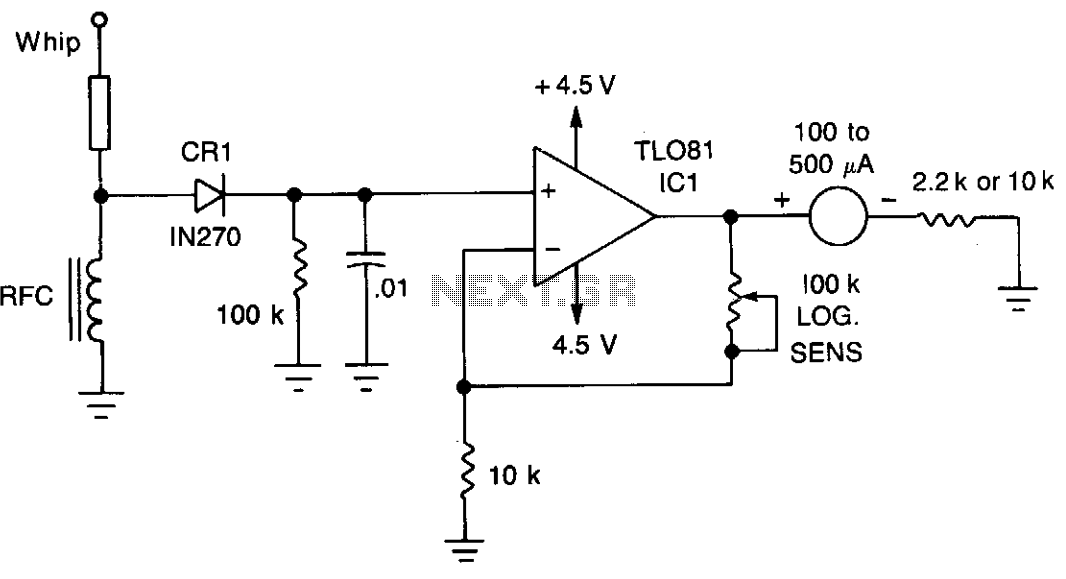
TV Relative Signal Strength Meter PCB

This circuit was designed to assist in the installation of TV antennas. The signal is monitored using a small portable TV set, and this circuit monitors the output of the TV's FM detector IC via a shielded lead. To initially calibrate the meter, trimpot VR2 should be adjusted to zero the meter. Trimpot VR1 serves as a sensitivity control and can be set for a preset reading (i.e., 0 dB) or calibrated in millivolts. Rotating the antenna for a minimum reading on the meter (indicating FM quieting) provides the optimum orientation for the antenna.
The circuit operates by utilizing a small portable TV set to monitor the signal strength received from the antenna. The core component of this setup is the FM detector integrated circuit (IC) within the TV, which converts the RF signals into an audio frequency that can be interpreted by the meter. The output from the FM detector IC is accessed through a shielded lead to minimize interference from external sources, ensuring accurate readings.
Calibration of the circuit is critical for optimal performance. The trimpot VR2 is used to zero the meter, establishing a baseline reference point. This step is essential for ensuring that subsequent readings accurately reflect the signal strength being received. The sensitivity control, trimpot VR1, allows for flexibility in the measurements. It can be adjusted to provide a preset reading of 0 dB or calibrated to display millivolt readings, depending on the user's preference or specific requirements of the installation.
To achieve the best reception, the antenna's orientation must be adjusted based on the readings from the meter. The goal is to find the position that yields the lowest reading on the meter, which indicates FM quieting. This phenomenon occurs when the signal-to-noise ratio is at its highest, resulting in a clearer audio output. By following this procedure, users can effectively optimize the placement of their TV antennas, ensuring the best possible signal reception for their viewing experience.
This circuit design provides a practical solution for installers and users alike, facilitating the installation process and enhancing the overall performance of TV antennas.Circuit This circuit was designed to assist the installation of TV antennas. The signal is monitored using a small portable TV set and this circuit monitors the output of the TV`s FM detector IC via a shielded lead. To initially calibrate the meter, adjust trimpot VR2 to zero the meter. Trimpot VR1 is a sensitivity control and can be set for a pre set reading (ie, 0dB) or can be calibrated in millivolts. Rotating the antenna for a minimum reading on the meter (indicating FM quieting) gives the optimum orientation for the antenna. 🔗 External reference
The circuit operates by utilizing a small portable TV set to monitor the signal strength received from the antenna. The core component of this setup is the FM detector integrated circuit (IC) within the TV, which converts the RF signals into an audio frequency that can be interpreted by the meter. The output from the FM detector IC is accessed through a shielded lead to minimize interference from external sources, ensuring accurate readings.
Calibration of the circuit is critical for optimal performance. The trimpot VR2 is used to zero the meter, establishing a baseline reference point. This step is essential for ensuring that subsequent readings accurately reflect the signal strength being received. The sensitivity control, trimpot VR1, allows for flexibility in the measurements. It can be adjusted to provide a preset reading of 0 dB or calibrated to display millivolt readings, depending on the user's preference or specific requirements of the installation.
To achieve the best reception, the antenna's orientation must be adjusted based on the readings from the meter. The goal is to find the position that yields the lowest reading on the meter, which indicates FM quieting. This phenomenon occurs when the signal-to-noise ratio is at its highest, resulting in a clearer audio output. By following this procedure, users can effectively optimize the placement of their TV antennas, ensuring the best possible signal reception for their viewing experience.
This circuit design provides a practical solution for installers and users alike, facilitating the installation process and enhancing the overall performance of TV antennas.Circuit This circuit was designed to assist the installation of TV antennas. The signal is monitored using a small portable TV set and this circuit monitors the output of the TV`s FM detector IC via a shielded lead. To initially calibrate the meter, adjust trimpot VR2 to zero the meter. Trimpot VR1 is a sensitivity control and can be set for a pre set reading (ie, 0dB) or can be calibrated in millivolts. Rotating the antenna for a minimum reading on the meter (indicating FM quieting) gives the optimum orientation for the antenna. 🔗 External reference





